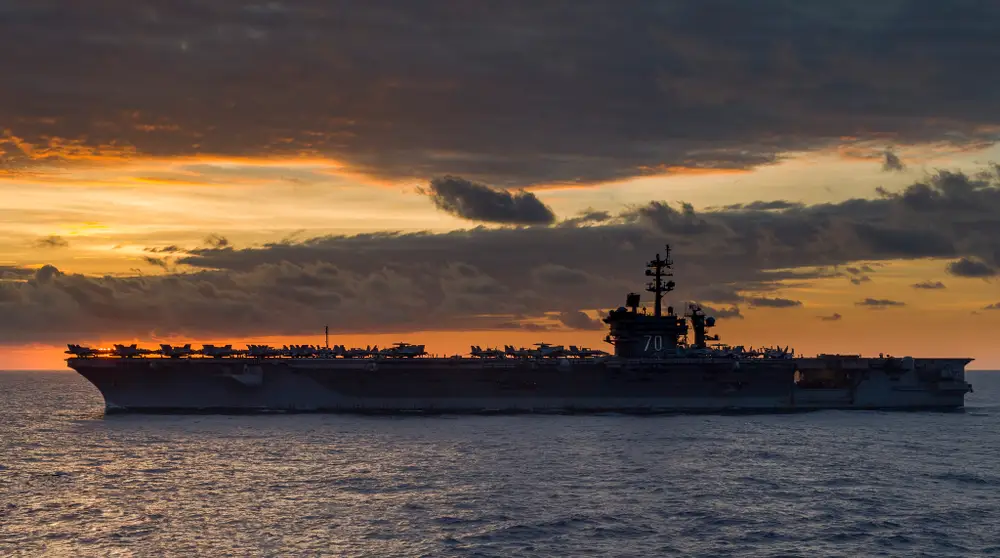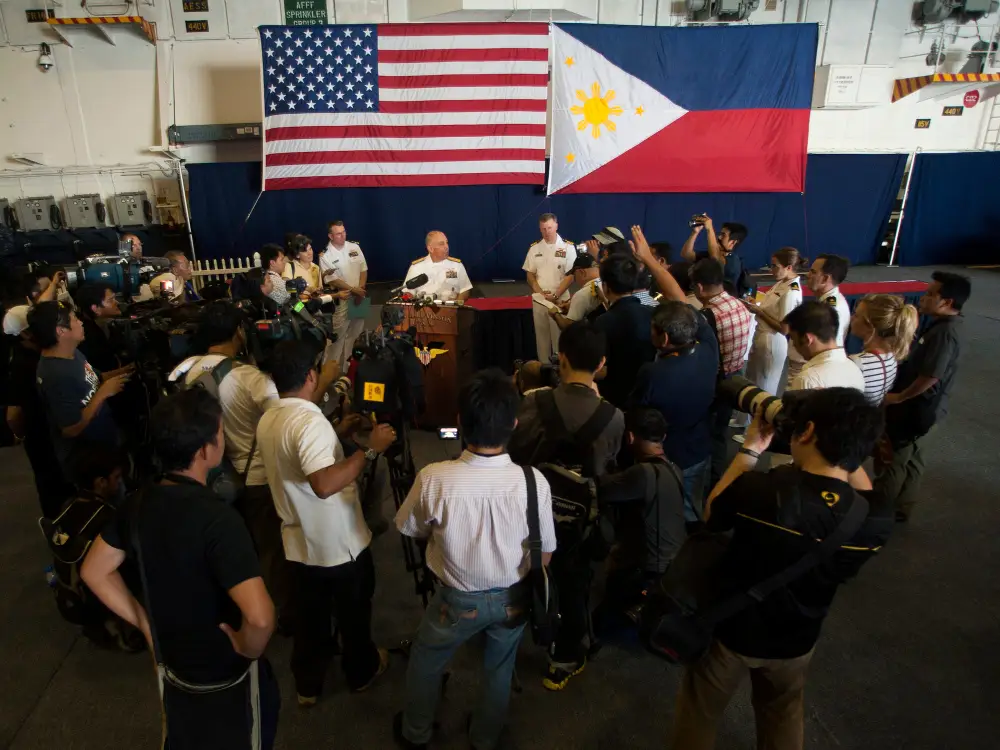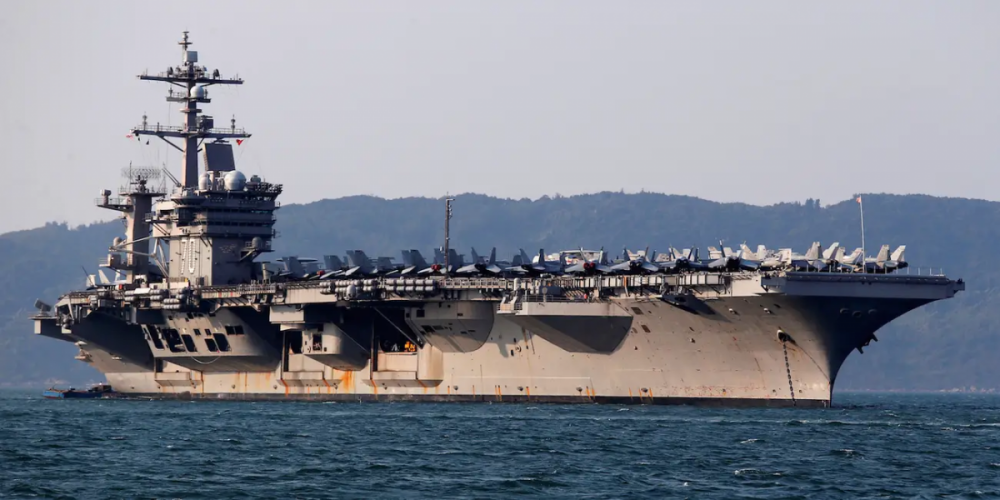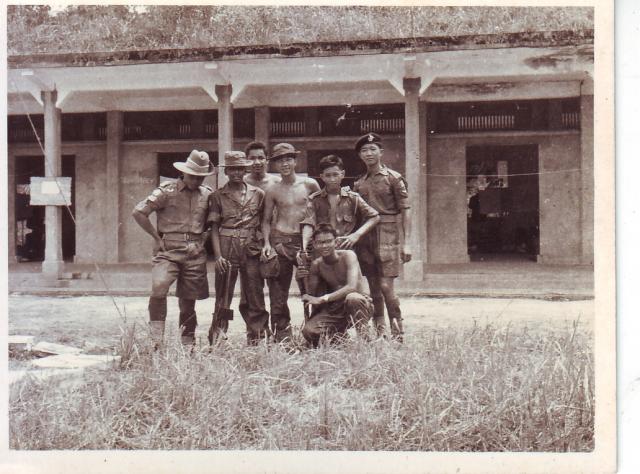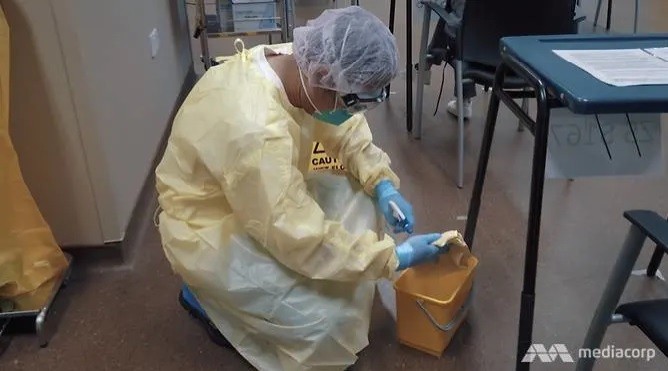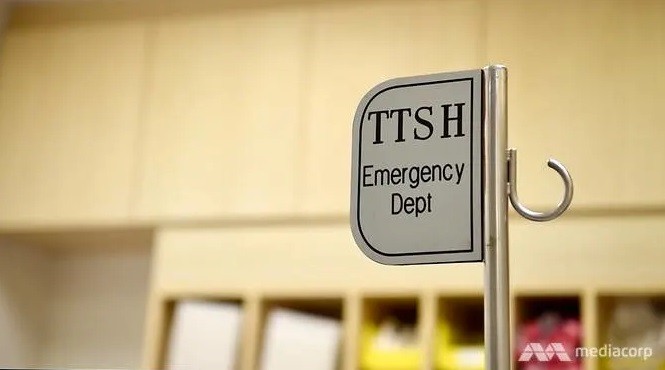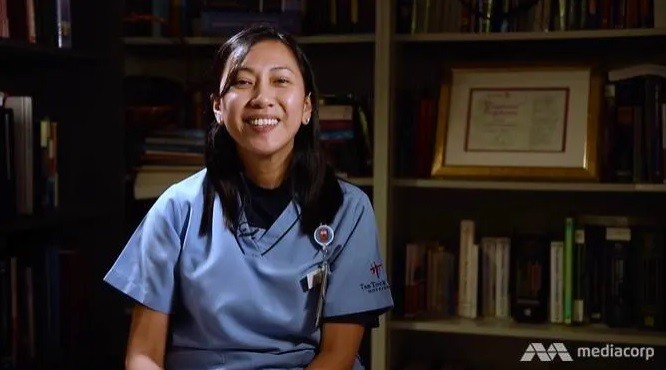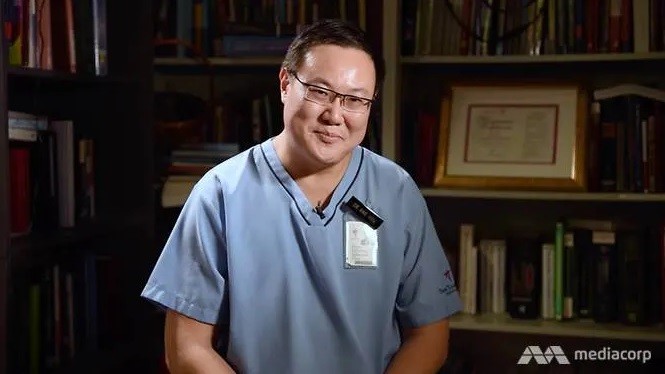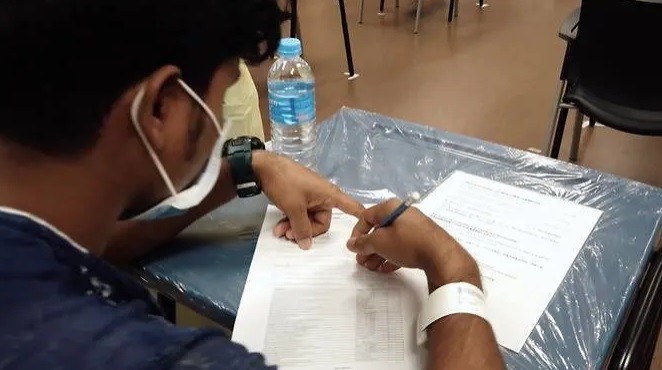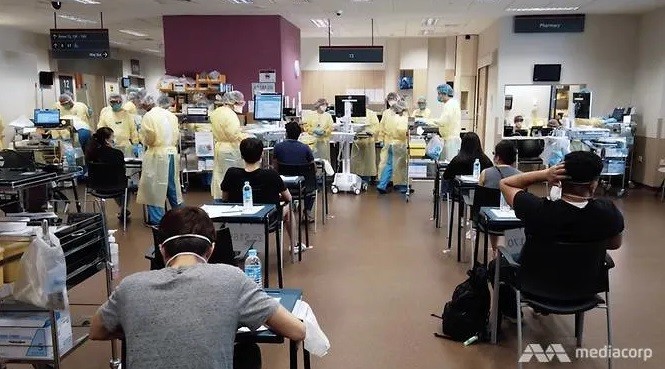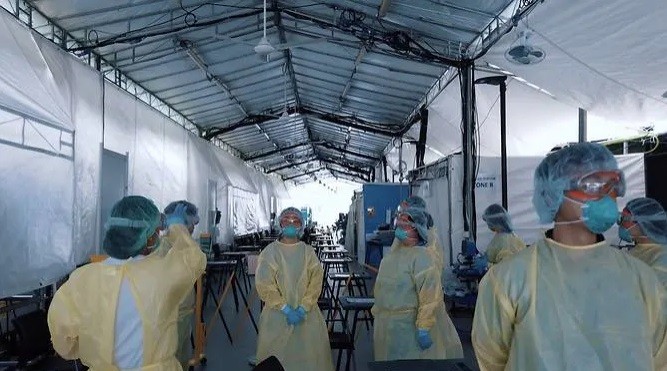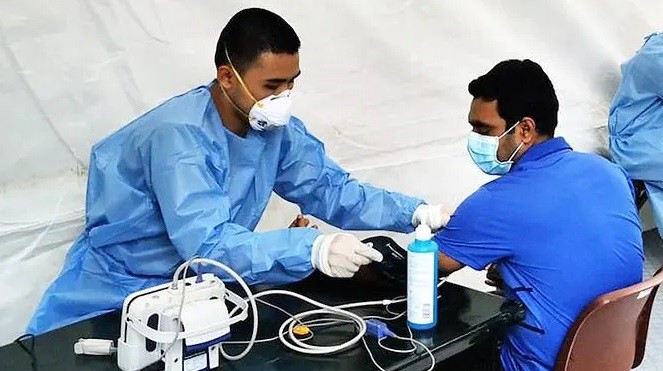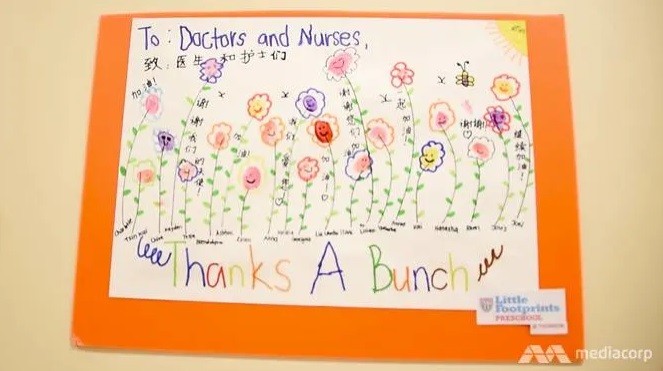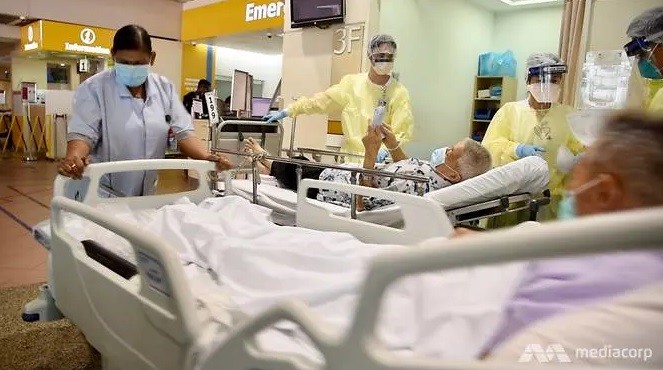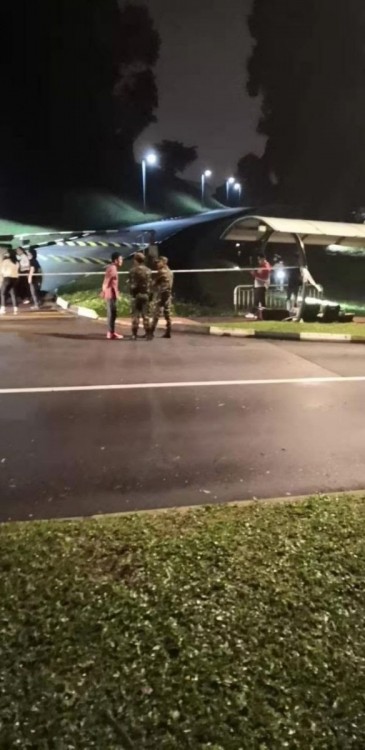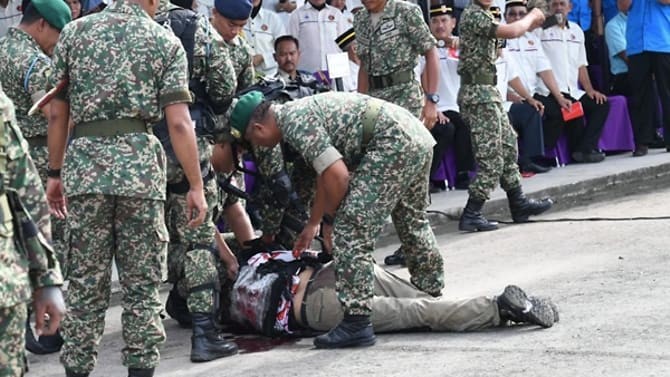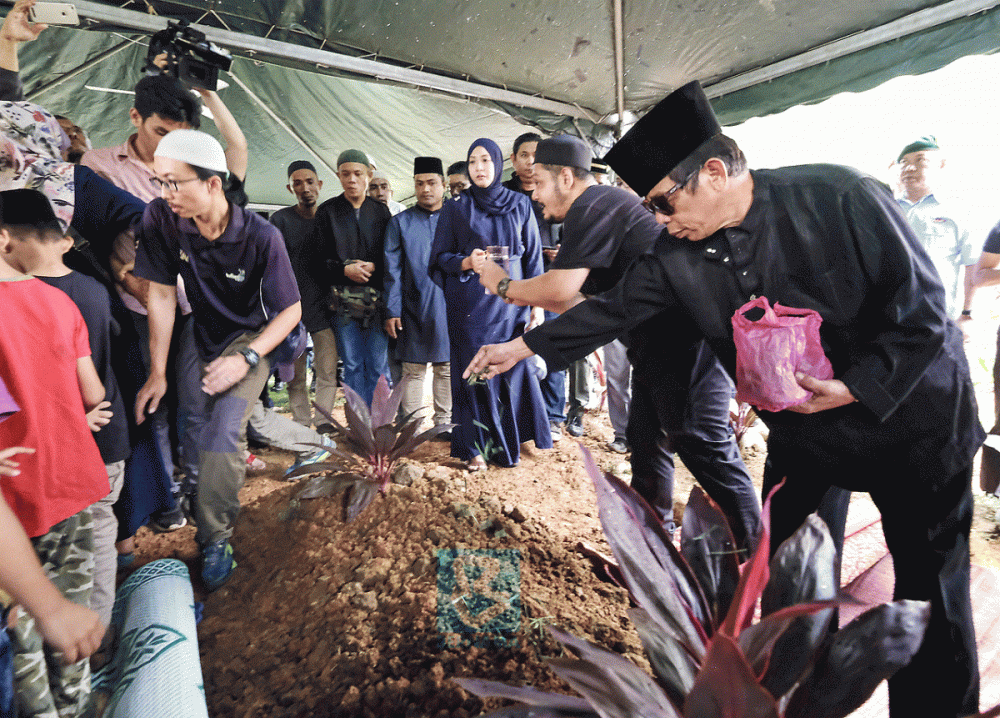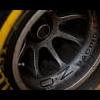Search the Community
Showing results for tags 'army'.
-
US aircraft carriers are taking new routes into the South China Sea, Chinese think tank says. https://www.businessinsider.com/aircraft-carriers-new-routes-south-china-sea-think-tank-says-2022-1?utm_medium=social&utm_campaign=sf-insider-mildef&utm_source=facebook.com US Navy aircraft carrier USS Carl Vinson in Danang, Vietnam, March 5, 2018. REUTERS/Nguyen Huy Kham US carrier strike groups entered the South China Sea 10 times in 2021, compared with six times in 2020 and five in 2019. Use of alternative routes between islands may be designed to evade PLA radars and indicates skill diversification for US sailors, defence experts say. The US Navy's aircraft carrier strike groups have not only increased South China Sea transits since last year, but their routes and drill patterns are becoming more complicated and unpredictable, according to a recent study. Defence experts said the changes could indicate new countermeasures devised by the strike groups to face any contingencies in the region, such as a potential attack on Taiwan by Beijing's People's Liberation Army, or over South China Sea territorial disputes. Beijing sees self-ruled Taiwan as a renegade province awaiting reunification, by force if necessary. It is also one of the rival claimants to several small islands and reefs in the busy shipping lanes of the resource-rich South China Sea. The US demands freedom of navigation in the region. The USS Carl Vinson CSG completed a five-day joint drill with the Essex Amphibious Ready Group (ARG) around the disputed Spratly Islands on Saturday, kicking off their 2022 naval schedule two weeks earlier than last year, according to the South China Sea Probing Initiative (SCSPI), a maritime strategic study unit affiliated to Peking University's Institute of Ocean Research. USS Carl Vinson the South China Sea. U.S. Navy photo by Mass Communication Specialist Third Class Jasen Morenogarcia/Released "The US military have drastically reinforced their military deployment in the South China Sea since last year, in terms of training scales, sorties and scenarios," SCSPI director Hu Bo told state broadcaster China Central Television (CCTV) on Friday. "USS [US ship carrier strike groups] entered the South China Sea 10 times last year, compared with six times in 2020, and five in 2019, with their training patterns becoming more complicated and unpredictable." In the past, the US warships used to enter the region via the Bashi Channel between the Philippines and Taiwan, but their routes and operation time spans had become diversified since last year, he added. Navigation records and satellite images show that the strike groups had tended to pass through narrow waterways between the Philippine archipelagos on their way to the region, including the Balabac Strait off Palawan province, a channel between Verde Island and Mindoro, and other points, the CCTV report said. In the latest transit last Tuesday, the CSG led by the USS Carl Vinson aircraft carrier entered the region via the Balabac Strait to team up with the Essex ARG, a landing helicopter dock group, according to the US Navy. Lu Li-shih, a former instructor at Taiwan's Naval Academy in Kaohsiung, said the US strike groups appeared to be trying to come up with new countermeasures to the PLA's anti-access strategies aimed at stopping foreign military interventions in waters off Taiwan and in the South China Sea. A press conference in the hangar bay of US Navy aircraft carrier USS Carl Vinson while anchored in Manila Bay, Philippines, November 30, 2010. US Navy/PO2 James Evans "I believe the US Navy is trying to escape the over-the-horizon (OTH) radars systems on the three artificial islands of Mischief, Subi and Fiery Cross reefs, which has targeted US warships and aircraft [before]," Lu said, referring to Beijing's three artificial islands in the Spratlys. "The US Navy can use the geographical features of the Philippines to approach the region and suddenly appear somewhere out of the PLA's expectations, because the OTH radars have limitations when it comes to monitoring approaching objects from a group of archipelagos." The USS Carl Vinson strike group fleet includes destroyers, frigates, submarines and supply ships. The new approach of warships sailing between island groups would also require US sailors to boost their skills in traditional terrestrial navigation, Lu noted. Collin Koh, a research fellow from the S. Rajaratnam School of International Studies in Singapore, said the new movements and choices of route were in keeping with the dynamic force employment concept implemented by the US Navy. "Instead of using only those traditional routes, the increased use of lesser-known, alternative routes would reduce predictability with respect to the direction of movement of US military assets," Koh said. "This thereby increases operational and strategic flexibility in times of peace and contingencies. Such contingencies would include the Taiwan Strait scenario to be sure."
-
According to the media: Jacky decides to donate all his assets to charity and would not leave a cent for his son, Jaycee Chan Jacky says "If he (Jaycee) is capable, he can make his own money. If he is not, then he will just be wasting my money.." Jacky says "I really regret not sending him into the army in the past, to give him more experience and temper his character..." People's Liberation Army, anyone?
-
Happy SAF Day all Singaporean son! Let be proud that we have done our part in serving our nation. To commemorate NS55, The Straits Times ART Department has illustrated a cartoon for the Straits Times NS55 contest. Let have some fun while recalling the unique experience we had during our NS days. Standby bed in Parade Square is a norm during my era, while the snake queue for coin phone, survival training, "Merlion" (after a water parade), blanket party, sniper, signaller, demo man, engineers, etc. are missing from this illustration. Those were the days...
- 393 replies
-
- 27
-

-
.png)
-
- national service
- army
-
(and 2 more)
Tagged with:
-
It is safe to say that one way or another, the majority of Singaporean men have served their country. Be it sleeping in the jungles of Mandai, walking the beat on the streets of Clarke Quay on New Year’s Eve, or putting out fires (literally) clad in heavy protective gear, most local and naturalised male citizens have given up, as the song goes, “two years of our time”. But many have differing views of National Service. Some see it as a hindrance, a waste of time. Some see it as an opportunity to get fit and test their limits via command school. Some prefer simply going through the motions, doing whatever their superiors tell them to. Me? I reasoned to myself that since I’m going to have to do it anyway, I might as well go in with an open mind and seek enjoyment in wherever CMPB decides to throw me. Who says you can't hear pictures? The sounds are embedded in my memory for life. Finding diamonds in the rough Did I have a good time? In a manner of speaking, yes. I forged lifelong friendships, I probably hit my peak fitness (getting thrown into a “chiongsua” vocation will do that to you), and I came out with the mantra that whatever else I may face in the future, it can’t be as bad as trying to get some sleep in a torrential downpour in the Lorong Asrama vegetation, soaking wet and desperately shielding my weapon with my body to prevent potential rusting. And on the first night of a five-day exercise too. There is truth too, in what your seniors would presumably have told you before you enlisted: You will definitely see all manners and types of people in the service. Hearing of the different stereotypes and seeing them with my own eyes definitely made for a humorous experience, especially during BMT. Don't judge a book by its cover There was the stereotypical “JC kid” recruit who was presumably sheltered and pampered for his entire life. He who struggled with simple chores like straightening his bedsheets (because Maria or Mama would do it for him), sweeping the floor of his bunk (I have literally heard, with my own ears, someone say that he did not know how to do it because he had never done so in his whole life), or propping two mattresses against each other in an upside-down V-shape. To give some context for the last example, my BMT company was tasked with sunning our mattresses in the courtyard on a particularly hot day. The obvious solution was to prop two of them against each other at an angle (like a tepee) and it would hold. We watched the other platoon (of which 95% were JC kids) stack them up like dominoes and struggled to understand why they kept falling over, creating a chain effect. That day, I learned that common sense was, in fact, not so common after all. My first day was a mixture of nerves and curiosity. And it is true what they say, that you struggle to sleep on your first night. I only managed to sleep for two hours. There was the stereotypical “poly kid” who would poke the cauldron of patience to see how far he could go with his bulls**t, who would usually follow orders but attempt to find an easier way to go about it. And the stereotypical “ITE kid” who would cuss a mean streak, go against his superiors, and usually did whatever they wanted. Of course, these are just stereotypes and not a generalisation. Most people whom I’ve had the pleasure or disdain of crossing paths with generally did not fit these stereotypes, save for a select few. And of course, last but not least, the “chaogeng warrior”. Every unit will have at least one such person, I guarantee it. He who possessed skin thicker than a rhino’s hide, he who knew full well what he was doing and what he could get away with, and he who spent more time at the doctor’s listing off ailments like a seasoned hypochondriac than in camp. My unit had one such person who, from the first day till the last, “chaogeng-ed” to an extent that I only ever had a conversation with him once, at the smoking corner. I now consider it a feat that in a “chiongsua” vocation like mine, he managed to avoid any and every physical training from the first day, for a duration of close to 20 months. He never even marched with us to the cookhouse once. I got the chance to learn how to ride a motorbike during my service. By now, you may have guessed what my vocation was. IYKYK. My takeaways (extra 30 cents) I did enjoy my time in the armed forces, to an extent. I did not like the constant once or twice-a-month weekend guard duties (my constant gripe was that there already was a specific vocation for it, yet we were forced to do either a full or half-day guard duty, on top of being physically exhausted from training the whole day). I bitched and whined like any true Singaporean would (how could I not?). I always tested the waters to try and make life more bearable (but I never did anything that would affect my bookouts, that was my threshold). But I came away a better person. My quick temper mellowed, I learned the value of discipline and patience, and I started to take my future a lot more seriously. All in all, I only enjoyed my National Service because of the attitude I decided to go in with. For all that’s being said of it being a waste of time, logically speaking, it’s something one has to do anyway, so why not try and enjoy it as much as possible? It’s only a waste of time if one deems it to be. ~ Fremont (Images by The Singapore Army)
-
- singapore army
- national service
-
(and 5 more)
Tagged with:
-
I’ve always held a keen interest in the armies of the world, the wars that raged, and the weapons used. Therefore, I usually appreciate a movie (preferably an action film) if there’s an army element and lots and lots of bullets involved. Well, Battle Los Angeles (2011) doesn’t disappoint. With explosive battles and intense drama, you find yourself rooting for a group of resilient Marines tasked with defending Los Angeles from an alien invasion force. And yes, it’s on Netflix (for now), and no, I won’t spoil the plot for you. The film unravels in modern-day Los Angeles, which turns into a battlefield when alien invaders descend upon Earth. Major cities around the globe fall one by one, and Los Angeles suddenly looks close to being next on the list. The stakes couldn't be higher as a platoon of U.S. Marines steps up to defend the metropolis from overwhelming extraterrestrial forces. Led by the Staff Sergeant Michael Nantz, played by Aaron Eckhart (who you might know from Olympus Has Fallen, London Has Fallen, and Midway), this plucky group of Marines embark on a mission that drastically changes with the circumstances. You might recognise famous celebrities such as Michelle Rodriguez (Letty from Fast and Furious), Ne-Yo (so sick of love songs, but not action films apparently), Michael Pena (Diller from 12 Strong, another must-watch war flick), and a young Joey King. Personally, I’m not sure why this movie ranked as low as it did on Rotten Tomatoes. As someone who likes a military element and a decent plot, this didn’t disappoint. ~ Fremont (Images by Wallpaper Abyss/Alpha Coders)
-
https://www.facebook.com/events/714665128574791/ Some promotions worth taking note. No need to wear uniform, just bring along 11B will do.
-
Noticed there are scattered current affairs threads for stuff related to military hardware, tactics etc. I'll kick it off with some of the more interesting things I learned about recently: On the US front: The F-117A Nighthawk AKA "Wobby Goblin" has been retired since 2008, after a remarkably short service life. Its shootdown in Yugoslavia in 1999 and subsequent compromise of the technology could have been a factor. F-14 Tomcat flew its last flight in 2006 - the only operator of the F-14 is now the Iranian air force. Moving to the UK, The country that invented and perfected the VSTOL fighter, the Harrier jump jet, no longer operates the type as of 2011. As a consequence of the Harrier retirement, the Royal Navy operates three STOVL aircraft carriers that do not have fixed wing aircraft. The Royal Navy has recently launched their latest aircraft carrier, the angled-deck Queen Elizabeth, but it is solely dependent on the F-35B to enable it to operate as something more than a helicopter carrier. As a cost saving measure, it is conventionally, not nuclear-powered. Japan Incidentally, the JMSDF's Hyuga class of helicopter carriers are only slightly smaller than the Royal Navy's STOVL carriers - which used to operate Harriers. Malaysia In the 2014 version of Cope Taufan, Malaysia gave the Americans a first taste of the SU-30MKM and they brought their newest toy, the F-22 Raptor to play. During the 2013 Lahad Datu standoff, BAe Hawks operated as strike aircraft, with the RMAF's Hornets performing target designation. General The Rheinmetall 120mm gun, pretty much the standard Western tank gun, has a barrel life of between 50-400 rounds, depending on the type of ammunition fired.Feel free to add on, or discuss current affairs topics. Please stay away from sensitive issues such as discussing classified information, or peeing contests in declaring Country X is better than Country Y, or whatever. These are hypothetical scenarios, whereas there is plenty going on just with the turmoil the world is in currently, and over the past decade to talk about.
-
JOLLY is a British duo comprising Josh Carrott and Ollie Kendal, who try out and react to various products, the majority of which are food. In the past, Carrott and Kendal have reviewed army rations from a range of countries such as France, Korea, Australia, Germany and Russia. On Aug. 2, they shared that they had received a bundle of MREs (Meals Ready to Eat) from a Singapore supplier. https://mothership.sg/2021/08/jolly-youtubers-react-army-rations/
- 152 replies
-
- 4
-

-
.png)
-
- army ration
- army
-
(and 3 more)
Tagged with:
-
Recently, by an incredible stroke of luck, I came across the website of the army boys trade school. https://sites.google.com/site/mybalep/Home My dad's name is inside but I shall keep it secret. By another stroke of luck, I managed to actually email someone from the site and he knew my dad personally. He is not in Singapore but he has emailed me photos which I have never seen before and given me locations of their meet ups. What is the army boys trade school? Basically boys from Singapore and Malaya would join this. This was under the British. It is a school where they learned soldiering and also got an education as well. From what I understand, this education was more of a technical education where they learneda sspecific skill. As part of the British army, they too fought for Singapore during the confrontation years. Yet I have never seen a mention of them in mindef magazines. And I have never met a single person outside of family who has actually heard of this school, not to mention known someone from there. So now I have this opportunity to meet them. I am of two minds. One is not to meet as it might be awkward as they do not know me, just my father and he passed away close to twenty years ago. On the other hand, these people are old and the list of those who died are getting longer. If I don't try, i might never get another chance. If you were me, would you? By the way my dad's picture is inside so if anyone knows anyone from this picture can message me privately.
- 35 replies
-
- 13
-

-
10, 20 years from now, we want to remember the faces behind the success of defeating COVID-19. No doubt about it, we will win the fight against the virus. Here's a thread out of the many COVID-19 ones, to remember the people behind our success. From Doctors, Nurses, Cleaners, Social Distancing Ambassadors, SPF, SAF, SCDF, NEA, ICA, MFA ... Let's share stories about these angels. Here's one from NCID to start. Inside Singapore’s COVID-19 screening centre, on the front line against the disease As the number of cases continues to rise, it is all hands on deck at Tan Tock Seng Hospital and the National Centre for Infectious Diseases, where doctors, nurses and other healthcare workers screen hundreds of patients daily. SINGAPORE: At the National Centre for Infectious Diseases (NCID) screening centre, one important part of the defence against the pandemic has been none other than ice cream. Charmaine Manauis is hardly joking when she says that. She is the lead consultant in infectious diseases at Tan Tock Seng Hospital’s emergency department, which is in charge of the screening effort. “Ice cream is important; it makes us happy. You see everyone — they have ice cream, they perk up,” the doctor said about her colleagues, and herself. “Plus, it’s hot inside the personal protective equipment. So they love eating ice cream (in the pantry) during their break.” She is certainly not kidding about feeling the heat under their yellow gowns, shower caps, gloves, goggles and N95 masks, which they wear throughout their seven- to 10-hour shifts, except during breaks. “When I remove my yellow gown, I’m usually drenched. It’s really hot,” she said. “When I remove (my mask), then I feel as if I can breathe again.” That is how it has been for the staff running both the TTSH emergency department and the NCID screening centre in the time of the coronavirus. And it is not just emergency doctors who are seeing to the suspected COVID-19 cases. While their department used to have about 20 doctors on shift at any time in the day, it has been a whole new ballgame since Chinese New Year. Hundreds of doctors across different specialities in the hospital — from urology to ENT (ear, nose and throat) to plastic surgery — are being mobilised for training so they can carry out COVID-19 duties too. Since Singapore’s first confirmed case on Jan 23, more than 400 doctors from the hospital have been rostered to work at the NCID screening centre across the road. And the one co-ordinating their training is Manauis, the senior consultant leading the screening efforts — as CNA Insider finds out in an inside look at the frontline battle against COVID-19. GETTING WIND OF THE VIRUS ON HOLIDAY The 42-year-old as well as her boss — Adjunct Assistant Professor Ang Hou, head of the emergency department — were on holiday in December when they first heard of a mysterious disease in Wuhan. “I said, ‘Hm, this might be something.’ So when I came back, the department had already started screening,” recounted Manauis. “We started screening for (travellers from) Wuhan on Jan 2.” That was the day Singapore’s Ministry of Health (MOH) announced that it was monitoring the pneumonia outbreak closely, and sent a circular to medical practitioners here. Whispers of the severe acute respiratory syndrome (SARS) started “floating around” TTSH. “We were SARS central back in 2003, so that’s never left the DNA of the department,” said Ang. “You can’t help but relive memories that you’ve been through, especially when you know your colleagues and your friends had been affected very deeply.” The possibility of a second coming did not surprise him, however. “We were always anticipating something like COVID-19 ... We knew that it wouldn’t be a matter of if, but when,” he said. “We knew that by the time it were to come from Wuhan to Singapore, it would’ve been ... a significant outbreak in the world or at least in this part of the region.” The department started screening for the novel coronavirus (SARS-CoV-2) in a “very small, dedicated space”. But even “way before” Singapore’s Disease Outbreak Response System Condition alert was raised to orange, the number of people coming every day “was growing to a scale that we had to move out of (that) physical space”, he added. As the rest of the country wound down for Chinese New Year, furniture had to be moved in, and computers set up, for the NCID screening centre to be activated. “It was a very busy Chinese New Year for a lot of people, not because we were going around celebrating but because we were preparing for the next phase in screening,” said Ang. By Jan 29, the screening centre was up and running round the clock. FROM SCREENING CENTRE TO TENT Those first few weeks of the centre’s operations were “really hectic” for Manauis. “We were on call 24/7. Every Saturday, we’d train (staff). During the week, we’d look at protocols — we’d look at whether our processes were working well, whether we had to manage any choke points in the screening centre,” she recounted. One of those choke points were the X-ray rooms. “If the screening centre was full, then there’d be a queue for X-rays. And so we’d need more efficiency, more radiographers,” she said. Based on the travel history and the chest X-ray results, the doctors had to decide whether the patients had to be warded or could be discharged. For those who needed admission, those were uncertain times. They had many questions. “How long will I stay? What tests will they be doing for me upstairs? How about my family? Do they need to be admitted too?” cited Manauis. The numbers coming for screening kept rising until the load “became quite difficult at one point”, said Ang. That came about when the MOH changed the definition of a suspect case, following the transmission of the coronavirus at a health products shop visited by Chinese tourists. “That led to a lot of patients being referred by their doctors for screening because they’d come into close and frequent contact with travellers from China,” said Ang. “A lot of people in various industries came in, whether they were taxi drivers, tour bus drivers, people who worked in tourist attractions or hotels, airports and casinos. They were all flooding in.” So, after consulting the ministry, TTSH proceeded to swab and discharge these patients, “to conserve beds for patients who were really ill and needed treatment”. Then there was “a strange point in time”, when the number of people coming for screening and the cases confirmed as positive slowed down, even as the numbers were picking up in the rest of the world. “We knew that the numbers would go up sooner or later,” said Ang. “We knew that the screening centre might not be able to cope ... so we made the decision together with the ministry to set up a tentage, to expand the number of places available.” That ended up being the case. On March 23, the TTSH team screened the highest number of people until now: More than 520. “We call it the most terrible Monday,” said Manauis. “The patients came in the afternoon and at night. And at night, we have less manpower. We had to open the tentage until 3am, with a lot of patients having to wait a little bit longer. So that was a struggle.” MIGRANT WORKERS A NEW CHALLENGE There are still hundreds of patients screened daily, although the challenge as of late is not the numbers but the space needed, as the spike has been among migrant workers, and the tent outside the screening centre is “perennially full”. “For these foreign workers, we need to wait for swab results before they can be discharged (if they test negative). So we need a bigger waiting area for them,” said Manauis. “After that, they have to wait for transport also, to bring them back to their dorms. So they can wait for as long as, probably, 18 (to) 20 hours.” WATCH: An exclusive look inside the NCID screening centre (Dur 5:20) While there are now Swab Isolation Facilities like the CherryLoft chalets — where the workers can be sent after their nose swabs — these facilities “are quite full” nowadays, she added. The workers are otherwise unable to self-isolate. "Every day, we’d have to ask whether there’s any vacancy, and then they still need to wait for an ambulance or dedicated transport." While there is swabbing done at the dormitories now, some of the workers need to go to the screening centre depending on their symptoms. If they complain of chest pain or have difficulty breathing, for example, then they need an X-ray, a blood test or an electrocardiogram. As long as they are symptomatic or have had close contact with a positive case of COVID-19, they should be swabbed. An MOH circular sent on Thursday has also updated the swabbing criteria for everyone. Anosmia — the loss of the sense of smell, either total or partial — is now one of the symptoms to look out for, cited Manauis. “There were (research) papers that came out, and there were positive cases which presented only with anosmia,” she explained. The other symptoms still include fever, runny nose, cough, sore throat and gastrointestinal symptoms like diarrhoea or vomiting. Since she started on TTSH’s clinical protocols and work instructions for COVID-19 screening and infection controls, Manauis has developed 61 versions for the staff to follow. There is also a workflow for the foreign workers from dormitories, which is at version 17 now. IN FOR THE LONG HAUL She has also trained nine batches of doctors from various departments, with as many as 51 physicians in a batch. They work a 10-day cycle as part of a group of more than 100 people, including nurses and other healthcare workers, running the screening centre. Most of them, even senior specialists, are volunteers, and some have done more than one rotation, although each department is also supposed to contribute a certain amount of manpower. “Screening is very different from what they do every day. So it wasn’t a surprise that they were a little bit apprehensive. But they were very willing to help out,” said Manauis. She is grateful for all the support. At one of the training sessions this month, she told the doctors: “We really need your help on the front line. On behalf of the emergency department, I thank you guys for volunteering.” The thing is, her department is not only working at the screening centre, but also attending to the usual emergency cases. To do this, the staff have cancelled their leave and reduced their days off. “You just have to do your work. I go day by day — whatever needs to be done, needs to be done,” she said with a shrug. “Everyone’s made sacrifices, not only me or not only the doctors ... But we do this willingly because we know that this is our job.” The emergency cases are tended to in a different zone, although that does not mean the staff necessarily get to dispense with personal protective equipment. The forward screening triage nurses, for example, must wear the full equipment. “Sometimes walk-in patients ... are close contacts (of a COVID-19 case), so we have to protect our frontline staff,” said Manauis. To protect the patients as well, one of the changes made is to ensure that they queue at least two metres apart. This, and many of the current arrangements in the emergency department, could be in place for some time. “For those of us who’ve been here for a while, who’ve gone through other outbreaks, we know that, potentially, it’s going to be long-drawn,” said Ang. “It could affect some of our own members — that the memories of SARS come back — and I think it might hit those (employees) a little bit harder.” When asked on Friday about her team’s morale, Manauis, who has been with TTSH for 15 years, gave a cheerful reply. “We’ll try our best to ... help the nation, especially now that (the number) of positive cases has been increasing,” she said. “We’re still okay. We still have ice cream, so we’re happy. I mean, you’ll need to try and pace yourself because we know that this is going to stay for a few more months.” https://www.channelnewsasia.com/news/cnainsider/inside-singapore-covid-19-screening-centre-defence-disease-ncid-12656312?cid=fbcna&fbclid=IwAR2aRtq_Z2MAo0V4ZhWSMMaT9GnvC_-dupS3ZWBKls8QOzPkW7931n7Pa0M
- 105 replies
-
- 12
-

-
- healthcare
- doctors
- (and 7 more)
-
NTU Assault On Campus Reported, Police & Army Personnel Sighted In Ongoing Investigation On 14 Dec (Sat), police received a report of an assault at Nanyang Technological University (NTU). Police cars were seen around the area outside the School of Art, Design and Media (ADM). On 15 Dec (Sun), NTU Student Union posted an Instagram story warning those at campus to stay safe as there were fugitives on the run. The message reminds everyone in NTU at present to remain indoors. Other details unconfirmed, public advised not to speculate on causes There are several rumours floating around social media and WhatsApp group chats. We do not advise members of the public to spread these around and to wait for a verified source instead. It has only been confirmed that an assault has taken place, and that the army has been deployed to the NTU campus. Those entering and leaving campus are being questioned. They are advised to call 999 if they see anything suspicious, according to several verified sources.
-
In 2013 at the age of 55, Leon Margaret was ready to retire. But then she was asked to extend her service. Today, the 1st Warrant Officer (1WO) is 61-years-old and is the oldest female commander in Singapore’s Basic Military Training Centre (BMTC). Just as fit as other soldiers In an interview with Pioneer magazine, Leon talked about her role as a Platoon Commander in BMTC’s School 1, Charlie Company. Despite her age, she achieves a gold award for her Individual Physical Proficiency Test (IPPT) every year. Leon regularly leads route marches with a 20 kilogram field pack strapped to her back. She also shows her soldiers how to dig trenches, and sleeps in the jungle during field camp. Regular workout routine Her secret to keeping fit? On Mondays, Wednesdays and Fridays, she has morning training sessions. She also joins her recruits during their morning runs. On weekends, she exercises with her husband. It’s all about hard work and discipline, which is the example she sets for her recruits. She is strict but caring Leon is known to be strict with her soldiers as she pushes them to pass the various tests during training. If any of her recruits are struggling to complete an exercise, she will simply tell them: “Ancient lady can do, young boys cannot do?” But despite her strict nature, Leon cares a lot for her recruits too. Gives advice to her soldiers Leon makes it a point to write back to her recruits in their weekly reflections. She recalled one particular case where a recruit confided in her about struggling to communicate with his mother. She advised him to bring his mother out for brunch one day to have a talk with her. The recruit wrote back to Leon to thank her as he took her advice and it turned out successful. Her history in the army According to the Pioneer article, Leon joined the military in 1976 as a clerk, but 10 years later, she was given the opportunity to be a combat trainer, before moving on to serve as a combatant. After that, she served as an Officer Cadet School instructor, Signal specialist and Company Sergeant Major in the 8th Singapore Armoured Brigade. She was even deployed for a humanitarian mission in East Timor. Right before she joined BMTC, Leon held the record of the longest-serving woman in the Signal formation.
-
KOTA KINABALU: Malaysian police said on Thursday (Sep 6) they are investigating the death of a 36-year-old commando officer who was shot in a live-firing demonstration at Lok Kawi Camp in Sabah on Wednesday. Major Mohd Zahir Armaya was then rushed to the Queen Elizabeth Hospital in Kota Kinabalu, where he later died. Inspector-General of Police Abdul Hamid Bador said a probe will be carried out to identify the cause of the incident. “I am confident there is an SOP (standard operating procedure) and it may not be overlooked," he told reporters. "The demonstration was well organised but the accident still occurred.” He added: “The Sabah Police Commissioner will release a statement soon (on the development of the case).” Abdul Hamid also asked the public to refrain from posting any offensive comments online. TERRORIST ROLE-PLAY The exercise - held in conjunction with the launch of the Fifth Division Infantry and the 13th Infantry Brigade - involved a clash between a group of "terrorists" and the armed forces. All the participants wore bullet-proof vests. Major Mohd Zahir, who played the role of the terrorist leader, had fired a pistol at an army officer, causing him to fall on his knees in pain. The officer then stood up and fired his pistol at Mohd Zahir, who had a red bottle target on the back of his bullet vest. The shot caused Mohd Zahir to fall and two army personnel then pulled him to the side of the parade field. He appeared unconscious and was believed to have sustained serious injuries. An army medical team at the ceremony gave him first aid before sending him to hospital, where he was pronounced dead at about 9.20am. "WE WERE VERY CLOSE" On Wednesday, more than 1,000 people, including friends, family members and officials paid their last respects to Mohd Zahir at the Wardieburn Camp mosque in Kuala Lumpur. The late major's body was then buried at the Tambun Muslim Cemetery in Ipoh. He was survived by a widow and five children, aged between five months and nine years old. Mohd Zahir's father, veteran actor and comedian A R Badul, received the news of the incident from his daughter-in-law. “I received the news this morning and was shocked and sad. But I take it as a test from Allah," he told Bernama. “We were very close and he had contacted and met me before. I was told that the bullet went a little further than the bullet-proof plaque and hit his body.” Mirdat Mohamad, who is Mohd Zahir's uncle, said the family wishes for a thorough investigation to find the exact cause of the incident. "We wish for him to have a fair investigation, a fair trial and a proper closure. If this was negligence, hopefully it would not happen again in the future," said the 54-year-old. “We will leave it to the police and army." King Abdullah Ri’ayatuddin Al-Mustafa Billah Shah and his consort Azizah Aminah Maimunah Iskandariah expressed their sympathies and sadness to Mohd Zahir's family. Condolences also poured in from other Malaysian leaders, including the communications minister, the chief of army and Sabah's chief minister.
-
The US Army is currently testing a prototype all-purpose vehicle powered by a Subaru turbodiesel-electric hybrid drivetrain. Called the ULV (Ultra Light Vehicle), it is meant to replace the HUMVEE. Commissioned by the Secretary of Defense and developed by the US Army's TARDEC (Tank Automotive Research, Development and Engineering Center), the ULV addresses some of the HUMVEE's shortcomings and serve as the next generation of go-anywhere military truck. Unlike the HUMVEE's V8, the ULV's petrol motor is a Subaru turbodiesel boxer making 175 hp and 260 lb-ft of torque. However, even the military is changing with the times with a hybrid drivetrain. According to Jalopnik, the hybrid system is comprised of two Remy electric drive motors and a 14.2 kWh Navitas Li-Iron Phosphate Battery, which at peak power can generate 180 kW (241 hp). TARDEC says the ULV has a range of 337 miles at 35 mph on level ground. On pure electric power, it can cruise up to 21 miles with the advantage of doing so in sheer silence. The electric motors mean that a driveshaft is no longer necessary, and when combined with an improved undercarriage it's a significant improvement over the HUMVEE's ability to shield occupants from roadside mines, whose blasts originate beneath the vehicle. Though the Ultra Light Vehicle is so in name only, and at 13 thousand pounds actually weighs about 3,500 pounds more than the HUMVEE, it has a better power-to-weight ratio thanks to its hybrid drivetrain. In accordance with specs put forth by the Office of the Secretary of Defense, the vehicle will have a payload capacity of 4,500 pounds and cost of $250,000 per unit over a 5,000 unit production run. Testing is scheduled to finish sometime this year, whereupon a determination for production will be decided.
-
Brigadier-General (BG) Perry Lim Cheng Yeow will take over from Major-General (MG) Ravinder Singh as Chief of Army on 21 March 2014. PHOTOS Brigadier-General Perry Lim Cheng Yeow (left) will take over from Major-General (MG) Ravinder Singh s/o Harchand Singh (right) as Chief of Army on 21 March 2014. (Photo: MINDEF) ENLARGE CAPTION SINGAPORE: Brigadier-General (BG) Perry Lim Cheng Yeow will take over from Major-General (MG) Ravinder Singh as Chief of Army on 21 March 2014. The Ministry of Defence said the change is part of its continuing process of leadership renewal in the Singapore Armed Forces (SAF). BG Lim, currently Chief of Staff - General Staff, joined the SAF in 1990 and was awarded the SAF (Overseas) and President's Scholarship in 1991. During his military career, he has commanded the 1st Battalion, Singapore Guards, as well as the army's 3rd Division. He was also the chairman of last year's National Day Parade executive committee. The 41-year-old holds a Bachelor of Arts (Starred First) (Mechanical Engineering) from the University of Cambridge, United Kingdom. BG Lim was also awarded the Lee Kuan Yew Postgraduate Scholarship in 2008 to pursue a Master of Business Administration in INSEAD, Singapore.
-
The force of Singapore is strong today ! https://www.youtube.com/watch?v=QBgr9ebXQa8 Video is best enjoyed with quality earphones. View full screen on Youtube. I work on filming and video editing as my passionate hobby.. :)
-
Army regular found dead in SAF training area Published on Jul 16, 2013 10:52 PM By Jermyn Chow AN army regular was found dead in the Singapore Armed Forces training area in Lentor on Tuesday, said the Defence Ministry. In a statement released on Tuesday night, Mindef said First Warrant Officer (1WO) Rajendran Pachemuthu,51, was found hanging from a rope in the Lentor training area by two civilian contractors who were maintaining SAF training equipment. There was no SAF training conducted in the area in the last two days, Mindef added. The contractors reported the incident to Master Warrant Officer Ong Chin Sai, a commander from Engineers Training Institute, who headed to the site and made a police report at 12:20 pm.
-
No Photography, No Video Recording....... But Camera Phone allowed .... CNA report: 14 military camps to allow servicemen to bring in camera phones Posted: 31 August 2012 1336 hrs SINGAPORE: Fourteen military camps in Singapore will allow servicemen to bring in camera phones, starting from 1 September. Previously, all camera equipped mobile devices were disallowed in camps. The move is part of a six- to nine-month trial to give servicemen added convenience while performing their national service duties. Camps will be divided into "green" and "red" zones. Green zones are where camera phones will be allowed. When a servicemen enters a more sensitive red zone, camera phones have to be temporarily surrendered. Pulau Tekong Camp, Bedok Camp and Khatib Camp are taking part in the trial. - CNA/al Nowadays, which camera handphone do now have video recording facilities...
-
Former chief of defence force Neo Kian Hong, 49, will be appointed Permanent Secretary (Education Development) from July 1. With his appointment, the Education Ministry will have two permanent secretaries. Ms Chan Lai Fung, who has been Permanent Secretary (Education) since November, will continue in that post. Mr Neo joins the Administrative Service after completing an Advanced Management Program at Harvard University. He had retired from the Singapore Armed Forces (SAF) this year after an illustrious 30-year career. A SAF Overseas Scholar, Mr Neo was promoted to the rank of Lieutenant-General. He was chief of defence force from 2010 to March this year, when he led a push to have soldiers train with laptops and handheld gadgets.
-
Don't play play hor. Males keep complaining not fair. Now all mouths kena stuck already... http://www.channelnewsasia.com/news/singapore/saf-promotes-first-female/1942582.html?cid=fbsg
-
While we 1 min strip rifle,while ppl 3 min can strip and assemble a jeep. Zai https://www.facebook.com/video.php?v=673576676098247 by https://www.facebook.com/QSXXDDK.
-
http://www.news.com.au/technology/design/army-recruits-angry-about-having-to-buy-their-own-safety-equipment/story-fnpjxnlk-1227114541698 BTW the get A$44K a year.
- 15 replies
-
- australian army
- recruits
- (and 5 more)
-
http://www.chinapost.com.tw/taiwan/national/national-news/2014/08/05/414077/ROC-Army.htm TAIPEI, Taiwan -- Army Sergeant Hsieh Shu-chen (謝淑貞) has officially become the first female R.O.C Army Ranger after completing a rigorous 10-week training last week, local media reported yesterday. The 26-year-old Hsieh of the 21st Artillery Command under the 6th Army Corps was awarded the Ranger badge on Aug. 1 after successfully undergoing 10-week training at an Army Special Forces training center in the mountainous Guguan area in Taichung City (台中谷關), the reports said. The Army said Hsieh was one of the 26 that successfully completed the training. The course took in 54 candidates. She is the only female who completed the training. According to the Chinese-language Apple Daily, there were another three female candidates joining Hsieh when the training session began. But all three of them had washed out of the arduous training session within a week. After officially becoming an Army Ranger, Hsieh expressed gratitude to her fellow candidates and instructors. It is with their encouragement that she was able to pass the test, Hsieh said. There were times when she wanted to give up, but Hsieh said her mother always taught her not to give up halfway, a motto she keeps in mind. According to the Army Special Forces training center, a potential ranger has to complete a four-stage, 10-week training before participating in a four-day final test to become a ranger. Superhuman Training During the 10 weeks, a candidate has to run 10,000 meters every morning plus complete another 1,000-meter obstacle course. He or she has to swim another 1,000 meters every day at noon and wear 25 kilograms of equipment for a 10-kilometer walk. Each day concludes with muscular endurance training. A potential Ranger also has to undergo all kinds of extraordinary tests, such as overcoming a fear of heights by jumping into water from a 22-meter-tall platform. A trainee needs to overcome high-altitude-related problems and be able to swim in cold water, it noted. The final exam is a four-day mountain training at altitudes of 1,500 to 2,600 meters, with candidates resting less than five hours during the four-day span, the training center added. Hsieh did not get any special treatment during the process because of her gender, the Army said. Respect!! for most of us, even at our peak, I don't think we can finished this course.
- 75 replies
-
- 7
-

-
- female ranger
- army
- (and 4 more)
-
@jamesc will miss the buddy system dearly. SINGAPORE ARMED FORCES SCRAPS BUDDY SYSTEM WITH IMMEDIATE EFFECT http://www.allsingaporestuff.com/article/singapore-armed-forces-scraps-buddy-system-immediate-effect by Wan Dao Liao, Straight Times SINGAPORE - Singapore Armed Forces (SAF) has announced it has removed the "buddy system" from its combat doctrine with effect from today (10 July). In a press statement to the media, SAF spokesperson reiterated they are constantly reviewing its training procedures to ensure the SAF is "keeping up with the times". The "buddy system" is a traditional military doctrine which requires individual soldiers to function in pairs during training and operations to ensure safety and accountability. "The SAF is concerned that the buddy system which requires individual soldiers to be devoted to another soldier interferes with their mental development," spokesperson Brigadier-General Yee Ker Xing replied in a e-mail interview, " We would like our conscript soldiers lead a healthy lifestyle that allows them to transit normally into civilian life after they completed their mandatory service." The latest move by SAF coincides with National Library Board's removal of three children books which were criticised by pro-family groups as "anti-family" and "pro-gay". One of the books, "And Tango Makes Three" is based on a true story that tells the story of a pair of gay penguins which incubated a young bird and regarded it as their offspring. "Finally the army wake up already!" cheered Lance Corporal Hock Kian Peng, "My instructor always tell me must eat, sleep and shower with my buddy you know! Then they forced us to sleep together in a small tent in field camp for 7 days you know! So gay!" However, Brigader-General Yee declined to revealed the upcoming changes to the training doctrine, citing operational concerns. "Maybe army should also stop telling me my rifle is my wife lah!", Lance Corporal Hock added, "I look at my rifle cannot stim, how to marry? how to buy hdb then claim baby bonus, you tell me? PAP give money you don't take meh? Siao." - See more at: http://www.allsingaporestuff.com/article/singapore-armed-forces-scraps-buddy-system-immediate-effect#sthash.00cH0DEW.dpuf

